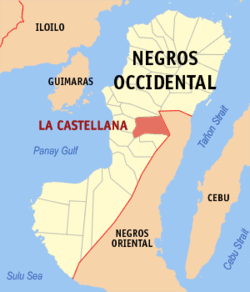La Castellana, Negros Occidental
| La Castellana | |
|---|---|
| Municipality | |
 Map of Negros Occidental with La Castellana highlighted | |
.svg.png) La Castellana Location within the Philippines | |
| Coordinates: 10°21′N 123°04′E / 10.350°N 123.067°ECoordinates: 10°21′N 123°04′E / 10.350°N 123.067°E | |
| Country | Philippines |
| Region | Negros Island Region (NIR) |
| Province | Negros Occidental |
| Congr. district | 5th district of Negros Occidental |
| Barangays | 13 |
| Government[1] | |
| • Mayor | Alberto A. Nicor Jr. |
| Area[2] | |
| • Total | 185.22 km2 (71.51 sq mi) |
| Population (2010)[3] | |
| • Total | 71,013 |
| • Density | 380/km2 (990/sq mi) |
| Time zone | PST (UTC+8) |
| ZIP code | 6131 |
| Dialing code | 34 |
La Castellana is a first class municipality in the province of Negros Occidental, Philippines. According to the 2010 census, it has a population of 71,013 people.[3]
La Castellana is a rural town situated at the base of Kanlaon Volcano, known for its natural springs, water falls and scenic spots. It is named after the famous "Paseo de la Castellana" in Madrid, Spain. It is an agricultural town engaged in sugarcane, rice and banana farming. It is home of many festivals namely Bailes de Luces, Banana Festival and Senior San Vicente Ferrer Feast Day where devotees far and near attend to for healing.
Barangays
La Castellana is politically subdivided into 13 barangays.[2]
- Biaknabato
- Cabacungan
- Cabagnaan
- Camandag
- Lalagsan
- Manghanoy
- Mansalanao
- Masulog
- Nato
- Puso
- Robles (Pob.)
- Sag-Ang
- Talaptap
Demographics
| Population census of La Castellana | ||
|---|---|---|
| Year | Pop. | ±% p.a. |
| 1990 | 54,368 | — |
| 1995 | 59,620 | +1.74% |
| 2000 | 59,102 | −0.19% |
| 2007 | 70,838 | +2.53% |
| 2010 | 71,013 | +0.09% |
| Source: National Statistics Office[3][4] | ||
References
- ↑ "Municipalities". Quezon City, Philippines: Department of the Interior and Local Government. Retrieved 6 March 2013.
- 1 2 "Province: Negros Occidental". PSGC Interactive. Makati City, Philippines: National Statistical Coordination Board. Retrieved 6 March 2013.
- 1 2 3 "Total Population by Province, City, Municipality and Barangay: as of May 1, 2010" (PDF). 2010 Census of Population and Housing. National Statistics Office. Retrieved 5 March 2013.
- ↑ "Province of Negros Occidental". Municipality Population Data. LWUA Research Division. Retrieved 19 August 2013.
External links
- Philippine Standard Geographic Code
- Philippine Census Information
- Local Governance Performance Management System
 |
La Carlota |  | ||
| Pontevedra | |
Canlaon, Negros Oriental | ||
| ||||
| | ||||
| Hinigaran | Isabela / Moises Padilla | Guihulngan, Negros Oriental |
This article is issued from Wikipedia - version of the 7/14/2016. The text is available under the Creative Commons Attribution/Share Alike but additional terms may apply for the media files.